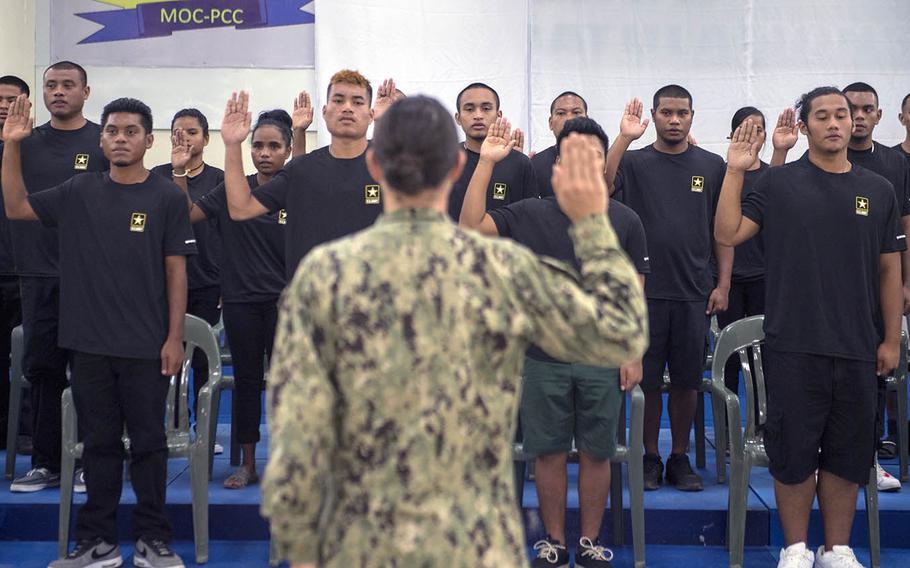
Lt. Cmdr. Gina Becker, commander of Honolulu Military Entrance Processing Station, administers the enlistment oath to enlistees in Koror, Palau, on July 20, 2018. (Kryzentia Richards/U.S. Navy)
About 200 soldiers are heading to Palau next week as part of Pacific Pathways, the first time in 37 years the Army has sent personnel to the nation of about 340 tiny islands in Micronesia.
An infantry company and a battalion tactical advanced command post from I Corps will conduct a security demonstration and small arms qualifications April 14-19 in Palau, U.S. Army Pacific said in a statement.
The Palau exercise is part of Pacific Pathways, during which soldiers are deployed in the Pacific for a series of back-to-back exercises. The Army is expanding the length of those deployments, increasing to four months this year, with six-month stints planned for 2020.
The current Pacific Pathways 19-1 consists of five exercises: Hanuman Guardian and Cobra Gold in Thailand, Salaknib and Balikatan in the Philippines and the upcoming one in Palau, where U.S. soldiers have not had a presence since 1982, the Army said.
The main site for the Palau exercise will be Ngeremlengui, located near Koror, the country’s primary commercial area.
At the same time, members from the 18th Medical Command will conduct humanitarian outreach on the Palau islands of Peleliu and Anguar, the Army said.
About 50 personnel from Palau will participate in the exercise.
“The focus of these events is to increase U.S. Army presence, gain positional advantage and reassure U.S. security commitments while increasing the USARPAC presence in the region,” the Army said.
As in other parts of the Pacific, China and the United States vie for influence in Micronesia, but America has long and deep ties with Palau.
The Palau archipelago was the scene of fierce battles during World War II. About 1,800 Marines and soldiers were killed in the three-month-long Battle of Peleliu in the fall of 1944. Another 8,000 were wounded.
Palau remained under U.S. administration for a half century after the war. In 1986, Palau and the U.S. entered a Compact of Free Association, which ushered in the nation’s full independence in 1994. Under the compact, the U.S. is responsible for Palau’s military defense for 50 years.
Through a Compact Trust Fund, the U.S. Congress appropriated financial aid packages for Palau. The trust fund undergoes a review and amendment process each 15 years, with the next review due in 2024.
Meanwhile, China had been making inroads with Palau through direct investment and through a steady flow of tourists to the country.
But in 2017, China banned tour groups from traveling to Palau because the island nation refused to drop official diplomatic relations with Taiwan, which China maintains is a renegade province and must, at some point, return to control under Beijing. Palau is one of fewer than 20 countries in the world that formally recognize Taiwan.
Reuters reported last year that former Palau government officials said Beijing was trying to buttress its influence in the region ahead of 2024 funding expiration by the U.S., which has not signaled if funding will continue.
—
Olson.wyatt@stripes.com Twitter: @WyattWOlson